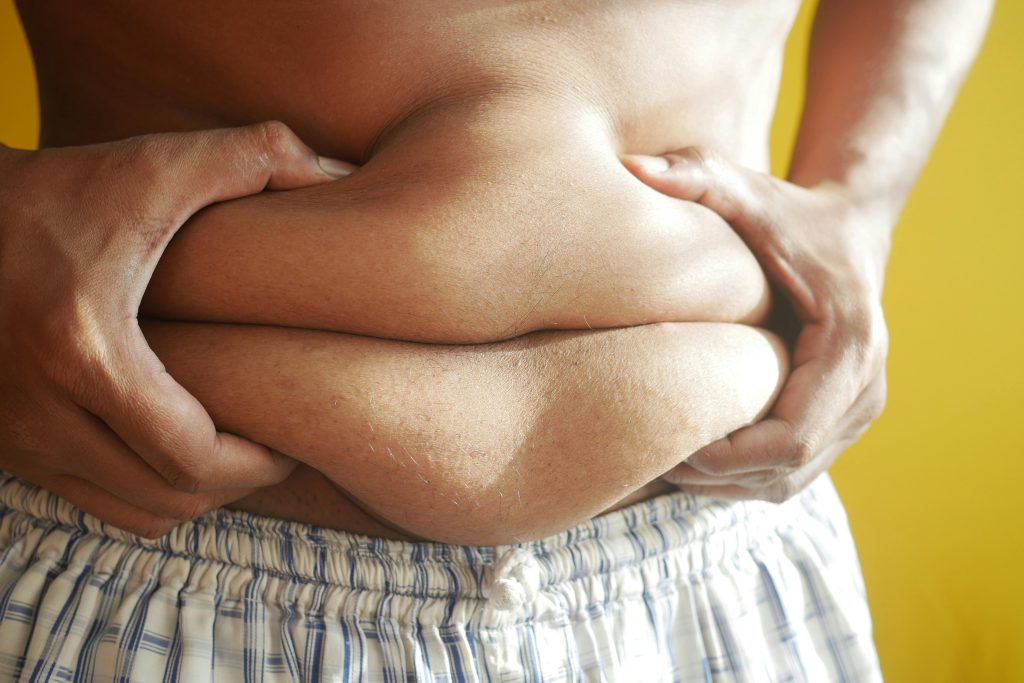The idea of spot reduction – targeting fat loss in specific areas of the body through diet or exercise – is a persistent myth in the fitness world. While it’s a tempting thought to imagine shedding those extra pounds just from your belly or thighs, the reality of how our bodies store and burn fat is far more complex and systemic.
Let’s delve into the science behind fat loss and why spot reduction through diet alone is a physiological impossibility.

Why You Can’t Choose Where You Lose Fat
Our bodies store excess energy as triglycerides in fat cells (adipocytes) distributed throughout the body. A combination of factors we can’t consciously control largely determines the distribution pattern of the fat cells:
- Genetics: Your genes play a significant role in where your body preferentially stores fat. Some individuals are genetically predisposed to carry more weight around their abdomen (android or “apple” shape). Others tend to accumulate fat in their hips and thighs (gynoid or “pear” shape). These genetic blueprints also influence the order in which your body draws upon these fat stores for energy.
- Hormones: Hormones like estrogen, testosterone, insulin, and cortisol influence fat storage and mobilization. For instance, estrogen tends to promote fat storage in the lower body in women, while testosterone can influence abdominal fat accumulation in men. Hormonal fluctuations throughout life stages (puberty, pregnancy, menopause) can also shift fat distribution patterns.
- Body Type: Somatotypes (endomorph, mesomorph, ectomorph) offer a general framework for body composition tendencies, influencing both muscle development and fat storage patterns.
- Age: As we age, metabolic rate can decline, and hormonal shifts can lead to changes in fat distribution. For example, some women may experience a shift towards more abdominal fat accumulation after menopause.
- Sex: As mentioned earlier, there are general sex-based differences in fat distribution due to hormonal influences.

When you embark on a weight loss journey through dietary changes, your body doesn’t selectively pull fat from one specific area. Instead, it initiates a systemic process of breaking down stored triglycerides into fatty acids and glycerol. They are then released into the bloodstream to be used as energy. The order in which these fat stores are mobilized is largely dictated by the genetic and hormonal factors mentioned above. Not by a conscious decision to target a particular body part.
Think of your fat stores as a network connected throughout your body. When energy demands exceed calorie intake, your body taps into this network. It’s akin to withdrawing money from different accounts – you don’t get to choose which specific dollar bills come out; the bank’s system determines that based on various factors.
The Role of Diet in Overall Fat Loss
While diet can’t target specific fat deposits, it is the cornerstone of overall fat loss. To lose weight, you need to create a calorie deficit, meaning you consistently burn more calories than you consume. This forces your body to tap into its energy reserves, which include stored fat.

Here’s how dietary changes contribute to overall fat reduction:
- Reducing Caloric Intake: By consciously choosing nutrient-dense, lower-calorie foods and controlling portion sizes, you can create the necessary calorie deficit for weight loss.
- Macronutrient Balance: The proportions of carbohydrates, proteins, and fats in your diet influence satiety, energy levels, and muscle maintenance during weight loss. Specialists usually recommend a balanced diet that prioritizes lean protein, complex carbohydrates, and healthy fats.
- Nutrient Density: Focusing on whole, unprocessed foods ensures you’re getting essential vitamins and minerals without excessive calories, supporting overall health and well-being during weight loss.
- Hydration: Drinking enough water plays a crucial role in metabolism, appetite regulation, and overall bodily functions, indirectly supporting weight management.
When you consistently maintain a calorie deficit through dietary changes, your body will gradually reduce its overall fat stores. While you can’t dictate the order of fat loss, you can influence the amount of fat you lose overall.

The Potential Role of Exercise (But Still Not Spot Reduction)
While diet is primary for creating a calorie deficit, exercise plays a vital supporting role in weight management and overall body composition.
- Increased Calorie Expenditure: Exercise burns calories, contributing to the calorie deficit needed for fat loss.
- Muscle Building: Resistance training helps build and maintain muscle mass. Muscle tissue is more metabolically active than fat tissue, meaning it burns more calories at rest. This can contribute to a higher overall metabolic rate, making it easier to maintain a calorie deficit over time.
- Improved Cardiovascular Health: Aerobic exercise improves heart health and endurance, supporting overall well-being during a weight loss journey.
- Potential for Localized Muscle Toning: While exercise can’t directly burn fat in a specific area, targeted exercises can strengthen and tone the muscles underneath the fat. This can lead to a more sculpted appearance in those areas as overall body fat percentage decreases. For example, doing abdominal exercises won’t make belly fat disappear, but it can strengthen the abdominal muscles, which will become more visible as you lose overall body fat.
It’s crucial to understand the distinction here: exercise can build muscle and improve the appearance of specific areas, but it doesn’t selectively burn the fat directly overlying those muscles. The fat loss remains a systemic process driven by the overall calorie deficit.

Why the Spot Reduction Myth Persists
Despite the scientific evidence against it, the spot reduction myth persists for several reasons:
- Anecdotal Evidence and Misinterpretation: People might believe they’ve lost fat in a specific area because they’ve been doing exercises targeting that area. However, this perceived loss is more likely due to overall fat reduction and increased muscle tone, not localized fat burning.
- Marketing and Misleading Claims: The fitness industry is rife with products and programs that promise targeted fat loss, often playing on people’s desire for quick and easy solutions. Scientific evidence doesn’t usually support these claims.
- Wishful Thinking: It’s natural to want to control where we lose fat, especially in areas we find problematic. This desire can make people more susceptible to believing in spot reduction strategies.
- The “Burn” Sensation: When you exercise a specific muscle group, you might feel a burning sensation. This is due to lactic acid buildup in the muscle, not the localized burning of fat in that area.
The Evidence Against Spot Reduction
Numerous scientific studies have investigated the effectiveness of spot reduction, and the overwhelming consensus is that it doesn’t work. For example:
- Studies examining the effect of abdominal exercises on belly fat consistently show that while the exercises strengthen abdominal muscles, they don’t lead to a greater reduction of fat in the abdominal region compared to overall fat loss.
- Research on arm exercises has similarly failed to demonstrate localized fat loss in the arms.
These studies consistently show that fat loss occurs throughout the body. And the areas where you lose it first and most significantly are largely determined by your individual genetics and hormonal profile.
Here you can read about fad diets and quick fixes, a topic closely related to spot reduction: https://www.bariradka.com/2024/11/05/forget-fad-diets-forever/

What to Do Instead: A Holistic Approach to Fat Loss
Instead of chasing the elusive dream of spot reduction through diet, focus on a comprehensive and sustainable approach to overall fat loss and body composition improvement:
- Prioritize a Calorie Deficit: This is the non-negotiable foundation of fat loss. Focus on a balanced, nutrient-dense diet that creates a consistent calorie deficit.
- Engage in Regular Exercise: Combine cardiovascular exercise for calorie burning and resistance training for muscle building and overall health.
- Focus on Overall Body Composition: Instead of fixating on specific areas, aim for a healthy overall body fat percentage. As your overall fat levels decrease, you’ll naturally see reductions in all areas, including those where you tend to store more fat.
- Be Patient and Consistent: Sustainable fat loss takes time and effort. Avoid fad diets and quick fixes, and focus on building healthy habits that you can maintain long-term.
- Embrace Your Genetics: Understand that your body has a natural predisposition for fat storage patterns. While you can influence overall fat levels, you can’t entirely change your genetic blueprint.
- Consider Professional Guidance: If you’re struggling with weight loss or have specific health concerns, consult with a registered dietitian or certified personal trainer for personalized advice and support.

In Conclusion
The idea that you can strategically diet to lose fat from specific body parts is a myth. It is rooted in wishful thinking rather than scientific reality. Fat loss is a systemic process influenced primarily by genetics, hormones, and overall energy balance. While diet is crucial for creating the calorie deficit necessary for fat loss, it doesn’t allow you to choose where that fat comes from. Exercise plays a vital role in overall health and body composition, but it also doesn’t enable spot reduction of fat.
The most effective approach is to focus on a sustainable, holistic strategy that includes a balanced calorie-controlled diet and regular exercise to reduce overall body fat. As your total body fat percentage decreases, you will see a reduction in fat across your body, including those areas you might be particularly focused on. Patience, consistency, and a focus on overall health are the keys to achieving your body composition goals.

